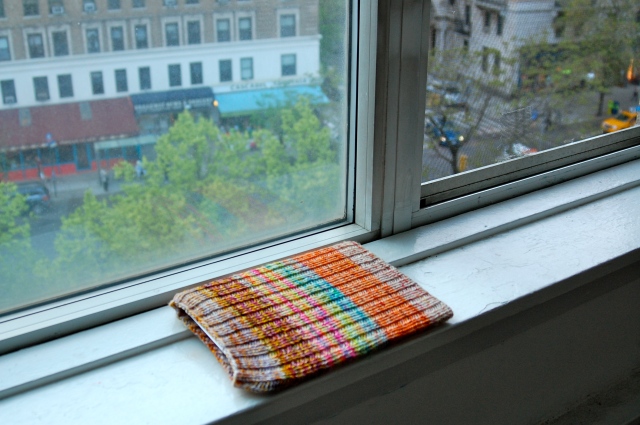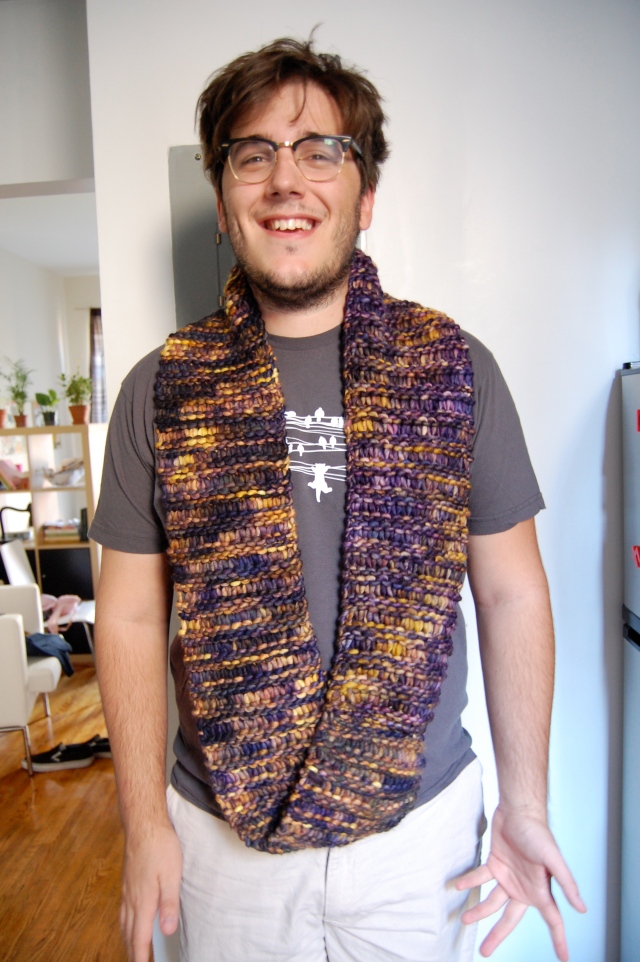About this pattern: One of the most exciting things about getting new electronics is thinking up a way to wrap them in delicious, squishy knitting. This very simple iPad 3 “sock” is snug, squishy, and soft – and easily knit in a couple days! This is a great small project that lets you play with color, since it’s all knit with sock yarn scraps.
Difficulty: Advanced beginner. Pattern requires: knitting, purling, joining in the round, Russian join and Kitchener stitch.
Needles: Size 6 (or size needed to obtain gauge)
Yarn: Sock yarn scraps or mini skeins. Don’t have any? Try asking your friends who are sock knitters or try joining a group on ravelry.com that hosts mini skein swaps! Another option is to search for mini skeins on etsy.com! I used just under 60g of various sock yarns, including (but not limited to) Socks That Rock Lightweight, Nooch Fiber Superwash Sock, Koigu KPPPM, and my own handspun. The idea is to have fun with different color combinations. Note: It does NOT matter if you have different amounts of each scrap!
Gauge: HOLDING YARN DOUBLE, 1”= 4 stitches across, 8 stitches down in stockinette stitch in the round. The gauge across is more important than the gauge down. I realize that the scraps you’re using might be slightly different weights – don’t worry if you don’t get the gauge quite right – there will be a check to make sure that the sock fits before you put too much time into it.
Pattern:
Note: The entire pattern is worked holding the yarn double.
Holding yarn from your first two scraps double, cast on 54 stitches.
Join in the round, making sure not to twist stitches. I used magic loop, but you can use whichever circular knitting method you prefer.
Row 1: *k2, p1* x18
Repeat this row until the work measures 1”.
VERY IMPORTANT STEP: Before you go any further, try slipping your work onto the iPad. The cast on edge should be tight and should look very small, but should still be able to be slipped on. If you don’t have an iPad, make a cardboard cut out to ensure that it will fit – the iPad is about 7.25” wide. If it doesn’t work, you need to start over with a larger needle. Always use the smallest possible needle to obtain gauge, as you want the sock to be as snug as possible.
Continue working in the ribbed pattern. Whenever one scrap of yarn ends, use the Russian join method to connect it to the next scrap (http://www.knittinganyway.com/freethings/russianjoin.htm). If you do not like this method, you can tie a small knot between the two yarns and weave in the ends when you complete the project.
Continue knitting until the work measures 11”. This is longer than the iPad, but the sock will become shorter when it is stretched over the iPad. Use Kitchener stitch (http://knitty.com/ISSUEsummer04/FEATtheresasum04.html) to bind off all stitches – this bind off should join both sides of the “sock” and create its base.
Weave in any ends.
Enjoy!











